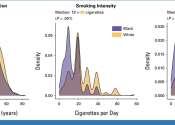Unlocking the mystery of preexisting drug resistance: Study sheds light on cancer evolution
The evolution of resistance to diseases, from infectious illnesses to cancers, poses a formidable challenge.
Jul 15, 2024
0
19
The evolution of resistance to diseases, from infectious illnesses to cancers, poses a formidable challenge.
Jul 15, 2024
0
19

Immunotherapy can be a highly effective treatment for non-small cell lung cancer (NSCLC), but some patients are resistant to the therapy or develop intolerable side effects.
Jul 12, 2024
0
59

Since the first immunotherapy drug to boost the body's immune response against advanced lung cancer was introduced in the United States in 2015, survival rates of patients with the disease have improved significantly. That's ...
Aug 5, 2024
0
2

Lung cancer remains the leading cause of cancer-related deaths worldwide. Detecting this disease in its early stages significantly improves survival rates, making low-dose CT screening an essential component in the fight ...
Aug 5, 2024
0
0

Early detection of lung cancer through low-dose computed tomography screening is one of the most promising strategies to reduce lung cancer mortality among high-risk individuals.
Aug 5, 2024
0
7

Among smokers, early menopause is associated with an increased risk for most lung diseases and poor outcomes, according to a study published online June 13 in Thorax.
Aug 1, 2024
0
0

We now have a dizzying array of heating technologies to consider, besides the fire that warmed our ancestors.
Aug 1, 2024
0
0

People who've had a history of smoking can get a lung cancer spotted early—when it's most treatable—through annual CT screening.
Aug 1, 2024
0
0

People who both vape and smoke are four times more likely to develop lung cancer than people who just smoke, according to new study published by The Ohio State University Comprehensive Cancer Center—Arthur G. James Cancer ...
Jul 31, 2024
0
52

An extensive analytical study performed at the Terasaki Institute and published in Frontiers in Immunology highlights the crucial role of tissue-resident memory T cells and how they influence the immune environment of patients ...
Jul 30, 2024
0
48

Lung cancer is a disease characterized by uncontrolled cell growth in tissues of the lung. If left untreated, this growth can spread beyond the lung in a process called metastasis into nearby tissue and, eventually, into other parts of the body. Most cancers that start in lung, known as primary lung cancers, are carcinomas that derive from epithelial cells. Worldwide, lung cancer is the most common cause of cancer-related death in men and women, and is responsible for 1.3 million deaths annually, as of 2004. The most common symptoms are shortness of breath, coughing (including coughing up blood), and weight loss.
The main types of lung cancer are small-cell lung cancer (SCLC), also called oat cell cancer, and non-small-cell lung cancer (NSCLC). The most common cause of lung cancer is long-term exposure to tobacco smoke. Nonsmokers account for 15% of lung cancer cases, and these cases are often attributed to a combination of genetic factors, radon gas, asbestos, and air pollution including secondhand smoke.
Lung cancer may be seen on chest radiograph and computed tomography (CT scan). The diagnosis is confirmed with a biopsy. This is usually performed by bronchoscopy or CT-guided biopsy. Treatment and prognosis depend on the histological type of cancer, the stage (degree of spread), and the patient's general wellbeing, measured by performance status. Common treatments include surgery, chemotherapy, and radiotherapy. NSCLC is sometimes treated with surgery, whereas SCLC usually responds better to chemotherapy and radiation therapy. This is partly because SCLC often spreads quite early, and these treatments are generally better at getting to cancer cells that have spread to other parts of the body.
Survival depends on stage, overall health, and other factors, but overall 14% of people in the United States diagnosed with lung cancer survive five years after the diagnosis.
This text uses material from Wikipedia licensed under CC BY-SA